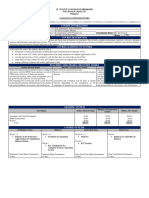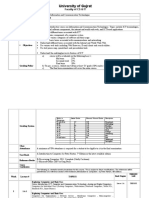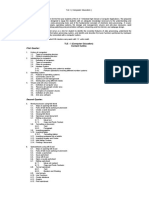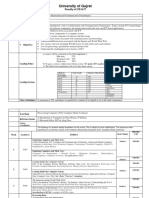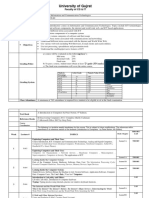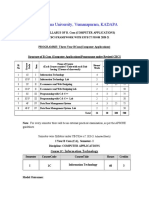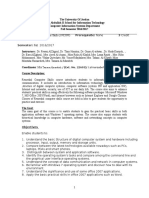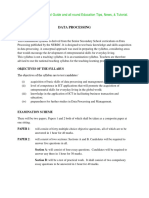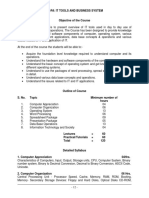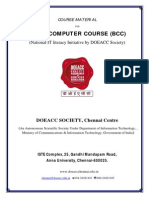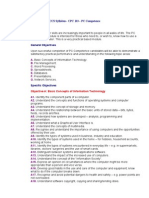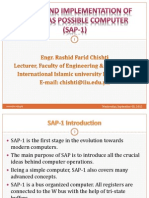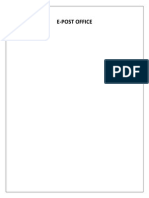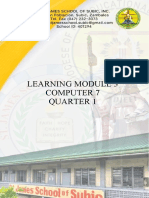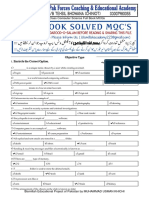Module 1 - Introduction To The Computer
Uploaded by
ScribdTranslationsModule 1 - Introduction To The Computer
Uploaded by
ScribdTranslationsIntroduction to Computing, Operating System
Windows -XX, Internet Navigation and
Office Suite Management
Presented by: Mgtr. Noemi L. Guerra
C.I. No. 2007-043-013
Program Planning
Occupational Vocational Training
a) General course information
Professional Family Computer Science
Course Name: Introduction to Computing, Windows OS -XX,
Internet and Office Programs
3. Modules and duration: 3 modules of 42 hours each
4. Headquarters: Gómez Primary School
5.Date: September 25 to December 28, 2010
6.Time: 5 – 9 p.m.
7. General Objective
At the end of the training period, the participant will be able to operate the
elements that make up a personal computer and apply the tools
basics of the Windows operating system -xx, browsing the Internet and operating the
text processor Ms Word, through the recognition of commands and functions
to design, create, and modify documents; in addition to building a spreadsheet
calculation, perform the statistical and graphical analysis of data using the application of the
Excel tools; and at the same time create presentations and slides using the application
of the PowerPoint tools.
8. Specific Objectives
Train the participant in the use of the personal computer.
♦Describe the terminology and applications in the use of the computer
♦Explain the basic functions of the Windows Operating System environment
Manage the accessories and windows of Windows
♦Know the communication possibilities of a computer
Interact with the communication tools offered by the Internet.
Define and use the utilities of a word processor
♦Explore the charting capabilities of a spreadsheet
Interact with the animation tools of a graphic presenter
b) Profile and access requirements for the participant
2.1 Level of General or Academic Knowledge:
Read and write.
2.2 Professional or Technical Level:
No prior technical knowledge is required in the area of the
Computer Science.
2.3 Physical Conditions:
None in particular except those that hinder the normal performance of tasks.
What does the module or course include?
2.4 Requirements:
Minimum age 17 years.
c) Number of participants
Minimum 12 maximum 20 participants.
d) Equipment and materials
4.1 Equipment and Teaching Aids
It will be used for theoretical and practical classes: Computer, Whiteboard,
Marker, Multimedia Projector, laser pointer, DVD player.
4.2 Teaching Material:
Participants will be provided with the essential study material for the
course development such as: manuals, CD-ROM with the documentation
used, bibliographic references, photocopies of technical documentation.
4.3 Protection and Security Elements:
In the development of the program, the necessary means will be used
safety and hygiene for an optimal development of teaching activities
learning.
e) Structuring of the course
The complete course has been divided into 3 modules that generally include the following
themes:
Introduction to Computing and Managing the Windows Operating System –xx
Management and navigation on the Internet
Use of office suite programs: Ms Word, Ms Excel, and Ms Power
Point
Instructional Modules Duration / Hours
1. Introduction to Computing ................................. 14
1.1 History and General Concepts
1.2 Hardware (Physical Components)
1.3 Software (Logical Components)
1.4 Information Storage
1.5 Communications and networks
2. Introduction and management of the Windows OS -xx ...... 14
2.1 Basic concepts and types of Operating Systems
2.2 Windows Environment
2.3 Windows Accessories
2.4 System Tools
2.5 Configuration
3. Navigation on the Internet ...................................................... 18
3.1 What is the Internet?
3.2 Technologies for Connection
3.3 Searches in Cyberspace
3.4 Email and Online Communication
3.5 Internet Security
3.6 The Web 2.0.
Use of Office Suite Software:
4. Microsoft Word (Word Processor)......……………….......... 28
4.1 Basic operations of Ms Word
4.2 Advanced operations and utilities
4.3 Tables, images, and graphs
5. Microsoft Excel (Spreadsheet).................................................. 27
5.1 MS Excel and its basic tools
5.2 Design of the electronic spreadsheet
5.3 Formulas and functions
5.4 Charts
6. Microsoft Power Point (Graphic Presenter)................................ 25
6.1 Basic Power Point Tools
6.2 Design of a presentation
6.3 Object Management
126 hours
f) Duration of the in-person time of the module
Theoretical hours ................................................................................... 42 hours
Practical hours ................................................................................. 59 hours
Evaluation hours ......................................................................... 25 hours
Total time .................................................................................... 126 hours
g) Evaluation guidelines for the module
In modular, open, and flexible teaching, the contents of a module are required and
they are closely linked to later knowledge, therefore it is essential to continue
the previously defined work schedule. In addition, both theoretical and content
The practical part of a module is what determines the type of evaluation that should be applied.
what will proceed in the following manner:
Theoretical-Practical Evaluation
Referring to evaluation as a process to determine the extent to which the objectives
of learning are being reached, we will apply those that we consider to be the most significant.
utility for this course: diagnostic or initial evaluation, formative evaluation or of
process and the summative, final, integrative, or outcome evaluation; relying on the
observation techniques, interrogation, problem-solving, demonstration, task
directed, among others. For example, written multiple-choice tests and oral tests will be applied.
and practical application through the development of individual projects, which
they will present before the group to complement the knowledge acquired by each one
the participants; in such a way that these mechanisms allow to demonstrate the degree of
students' learning regarding the studied modules.
h) Bibliography
. Aréchiga, R., 'Fundamentals of Computing', 2nd Edition, Limusa, 1985
Mexico.
. Introduction to Computing Technical Training Center SOEDUC. 2nd
edition. 2001.
. Kurose, J. Ross, K., “Computer Networking: A Top Down Approach
Featuring the Internet, 3rd edition. Ed. Addison-Wesley, July 2004
. National Employment Institute (INEM), Training Course Program
occupational professional. 1st ed. 1990.
. Concepts of Computing
9687529148. 1997.
. Baras, E.M., Ms Word, Ms Excel, Ms Power Point, User Guide. Mc
Graw-Hill. 1997.
. Teaching. Foundation and Practice.
Mexico
. N. Gómez, "Educational research: from hypothetico-deductive to what
"interpretative", Sinéctica, no. 7, iteso. 1995.
. M. Wittrock, The Research of Teaching II. Qualitative Methods and
observation, Paidós, Mexico. 1990.







